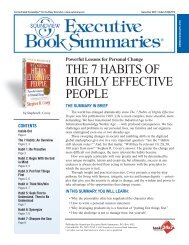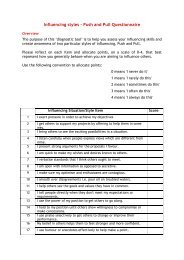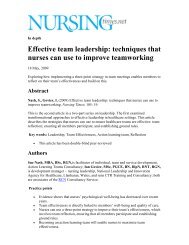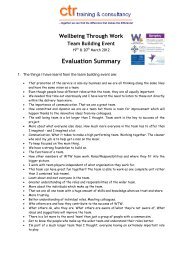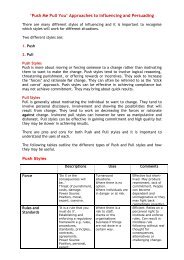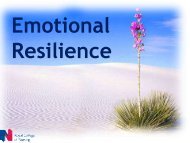The Work of Leadership by Heifetz and Laurie - CTR training and ...
The Work of Leadership by Heifetz and Laurie - CTR training and ...
The Work of Leadership by Heifetz and Laurie - CTR training and ...
Create successful ePaper yourself
Turn your PDF publications into a flip-book with our unique Google optimized e-Paper software.
<strong>The</strong> <strong>Work</strong> <strong>of</strong> <strong>Leadership</strong> <strong>by</strong> <strong>Heifetz</strong> <strong>and</strong> <strong>Laurie</strong><br />
About Review<br />
Review is a new publication for Welsh NHS Confederation members that aims to provide a literature<br />
review <strong>of</strong> key texts <strong>and</strong> ideas in health <strong>and</strong> related fields written <strong>by</strong> leading edge thinkers from around<br />
the world.<br />
Introduction<br />
As we approach the setting up <strong>of</strong> new unitary health bodies<br />
that will need to be organised <strong>and</strong> work differently from their<br />
predecessors, it is important to hear about others’ views <strong>and</strong><br />
experiences in managing change.<br />
<strong>The</strong> <strong>Work</strong> <strong>of</strong> <strong>Leadership</strong> is an article written <strong>by</strong> <strong>Heifetz</strong> <strong>and</strong> <strong>Laurie</strong><br />
that appeared in the January-February 1997 edition <strong>of</strong> the<br />
Harvard Business Review. It is based on <strong>Heifetz</strong>’s 1994 book<br />
‘<strong>Leadership</strong> Without Easy Answers’, <strong>and</strong> the core principles <strong>of</strong><br />
the article are further extended <strong>and</strong> developed in the 2002<br />
publication ‘<strong>Leadership</strong> on the Line: Staying Alive Through the<br />
Dangers <strong>of</strong> Leading’ <strong>by</strong> Ronald <strong>Heifetz</strong> <strong>and</strong> Marty Linsky.<br />
<strong>The</strong> article discusses the management <strong>of</strong> change <strong>and</strong> focuses<br />
on what is described as “adaptive challenge”, which is about the<br />
locus <strong>of</strong> responsibility shifting to the employees in a company<br />
where an adaptive change is required, <strong>and</strong> how the leader can<br />
help facilitate this.<br />
As Ronald <strong>Heifetz</strong> is a graduate <strong>of</strong> Harvard Medical School, it is<br />
perhaps unsurprising that the article begins with the allegorical<br />
tale <strong>of</strong> a doctor advising a patient <strong>of</strong> what changes <strong>of</strong> habits <strong>and</strong><br />
lifestyle are needed to lead a more healthy <strong>and</strong> better quality<br />
<strong>of</strong> life. <strong>The</strong> doctor is the leader <strong>and</strong> the patient the one who has<br />
the “adaptive challenge” to mobilise <strong>and</strong> make the changes. So it<br />
is in an organisation.<br />
<strong>The</strong> authors regard this role <strong>of</strong> leadership to be the most<br />
difficult. All organisations face adaptive challenges in markets,<br />
competition <strong>and</strong> technology, <strong>and</strong> the nature <strong>of</strong> the required<br />
adaptive work tends to face systemic problems where there are<br />
no obvious <strong>and</strong> easy answers. <strong>The</strong>y suggest that leaders should<br />
get away from the habit <strong>of</strong> providing solutions, <strong>and</strong> devolve this<br />
responsibility to the “collective intelligence <strong>of</strong> all employees”.<br />
<strong>The</strong> role <strong>of</strong> the leader in facing adaptive challenges is to protect<br />
employees from outside threats while allowing the pressures <strong>of</strong><br />
reality to be felt without too much distress – challenging values,<br />
beliefs <strong>and</strong> norms in the process.<br />
<strong>The</strong> six principles<br />
<strong>Heifetz</strong> <strong>and</strong> <strong>Laurie</strong> have identified six principles for leading<br />
adaptive work:<br />
1. Getting on the balcony<br />
2. Identifying the adaptive challenge<br />
3. Regulating distress<br />
4. Maintaining disciplined attention<br />
5. Giving the work back to the people<br />
6. Protecting voices <strong>of</strong> leadership from below<br />
Claiming that leadership is about more than identifying a<br />
vision <strong>and</strong> aligning the workforce with that vision, the first role<br />
in leading an adaptive challenge is the ability to observe <strong>and</strong><br />
mobilise.<br />
While a leader must be able to underst<strong>and</strong> the current business<br />
focus, he or she must also underst<strong>and</strong> the many reactions to<br />
change within the organisation. As if on a balcony with a clear<br />
view <strong>of</strong> all the organisation’s activities, moving back <strong>and</strong> forth<br />
between the “field <strong>of</strong> play” <strong>and</strong> the balcony view will allow the<br />
leader to mobilise the right people in the right way to do the<br />
necessary adaptive work. Without this overview the leader can<br />
become a prisoner <strong>of</strong> the system.<br />
<strong>The</strong> balcony view allows the leader to identify the second<br />
principle, the adaptive challenge needed. <strong>The</strong> authors illustrate<br />
how new adaptive changes can be quite challenging, this time<br />
using the simile <strong>of</strong> a b<strong>and</strong> <strong>of</strong> chimpanzees knowing how to<br />
respond to a threat from a leopard yet not knowing how to<br />
react to a human with a gun.<br />
<strong>Heifetz</strong> <strong>and</strong> <strong>Laurie</strong> move from simile to example in summarising<br />
the account <strong>of</strong> British Airways’ (BA) adaptive challenge in the<br />
1980s. It was during this period when BA’s new chief executive<br />
identified the need to change the values, practices <strong>and</strong><br />
relationships in the organisation to create a greater customer<br />
focus. <strong>The</strong> adaptive challenge was to establish trust throughout<br />
the organisation <strong>and</strong> this was achieved <strong>by</strong> the CEO <strong>and</strong> his team<br />
gaining ideas <strong>and</strong> consensus at all levels, identifying conflicts<br />
as clues to the underlying reality, <strong>and</strong> <strong>by</strong> holding a mirror to<br />
themselves to gain insight as to what was the best <strong>and</strong> worst <strong>of</strong><br />
the company’s values <strong>and</strong> norms.<br />
Describing leadership as a “razor’s edge”, the authors go on to<br />
explain that once the adaptive challenge has been identified,<br />
the leader’s next task is to generate just enough distress among<br />
the people in order that the need for change is felt <strong>by</strong> everyone.<br />
<strong>The</strong>y prescribe three fundamental tasks for a leader to regulate<br />
distress:<br />
• Create a “holding environment” <strong>by</strong> regulating new<br />
initiatives, introducing progress at the right pace.<br />
2






